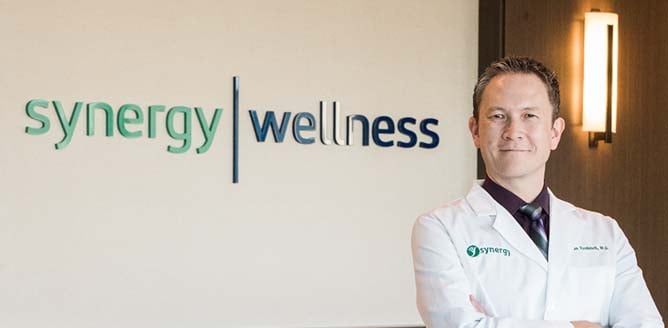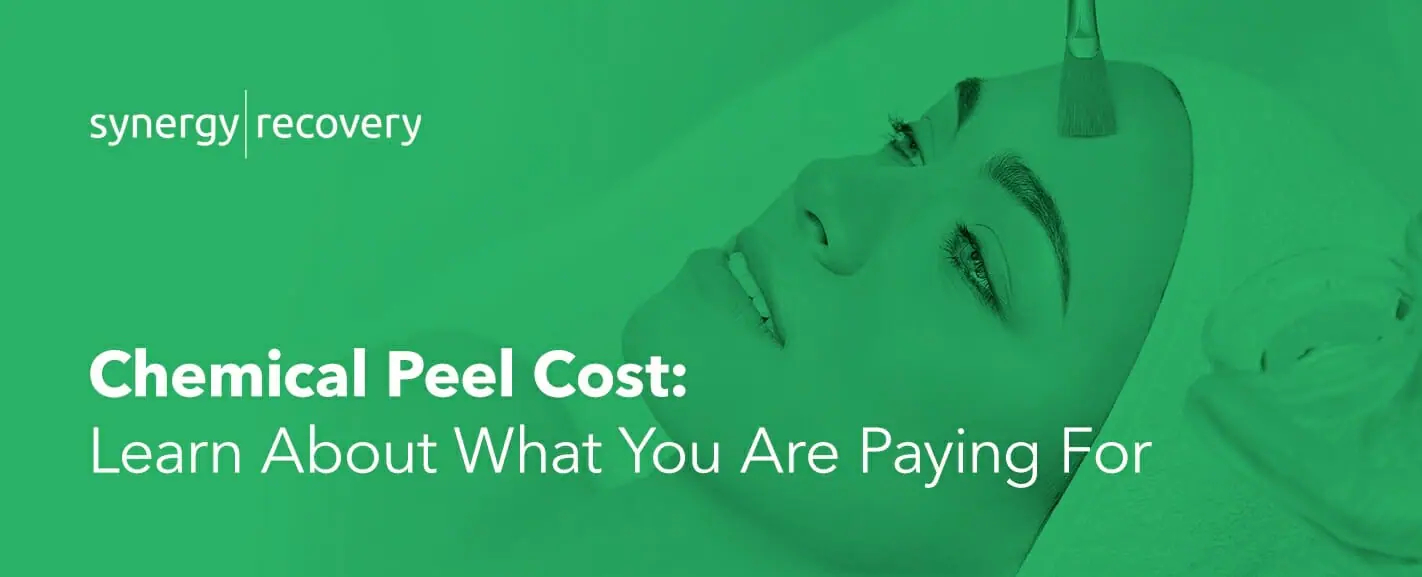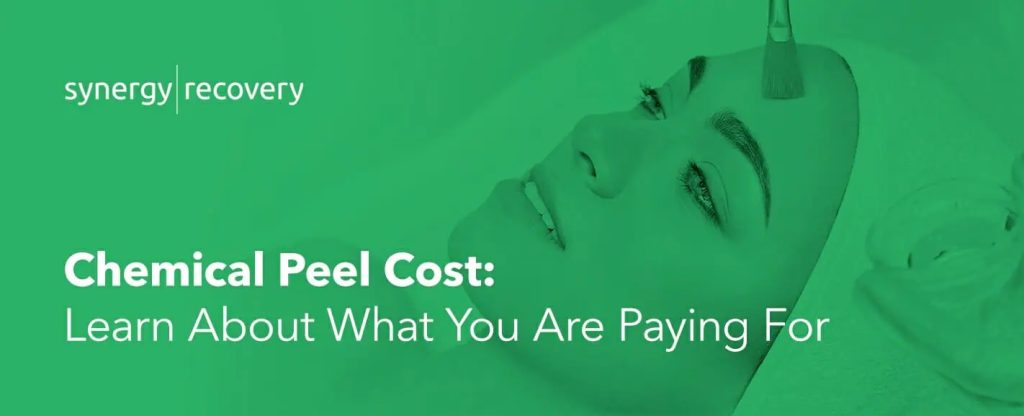
Perhaps you’ve noticed your skin doesn’t have the youthful glow it once did. Or you may have other concerns, such as acne, acne scars or stretch marks. For many people, these signs of aging or damaged skin can cause a dip in confidence. But there’s no reason you can’t be happy with your skin and have a healthy glow, especially with chemical peel treatments available.
If you’re considering this skin treatment, you probably have a few questions. In the guide below, you’ll learn about the chemical peel cost and what treatment entails. Decide if a skin peel is right for you to regain your healthy, happy skin.
What Is a Chemical Peel?
A chemical peel or skin peel is essentially a medical-grade exfoliation that involves applying a specially formulated solution to the skin. The chemical solution removes the top layer of skin tissue. The process reveals younger, fresher skin underneath and can address a variety of issues. With the top layer of skin removed through a chemical peel, you’ll say goodbye to dull, dead skin and hello to a firm, glowing complexion.
You can have a skin peel on most areas of the body. Common treatment areas for a chemical peel include the face, neck and arms. These are the most visible areas of our skin. That means they experience the most exposure to damaging sunlight, but they’re also the parts we present to the world. People seeking a chemical peel want to cosmetically improve these visible areas of skin, whether these are signs of aging, sun damage or different imperfections.
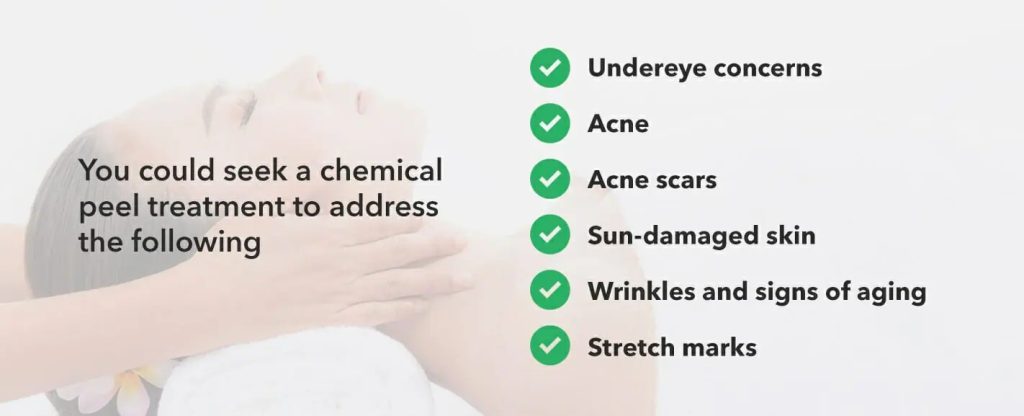
What Are the Benefits of a Chemical Peel?
A chemical peel comes with the benefit of revitalizing your complexion. You’ll see benefits such as a smoother texture and a more even skin tone with this treatment. For many clients, the results boost their happiness and confidence in their appearance. They regain a youthful complexion, and that makes them feel young again.
So is a chemical peel good for the skin? A chemical peel could come with benefits for damaged skin, uneven skin tones, textured skin and other issues. You could seek a chemical peel treatment to address the following.
- Undereye concerns: Swelling, puffiness and sagging under the eyes give us a tired appearance. A chemical peel under the eyes can address problems including puffy eyes, bags or wrinkles.
- Acne: Some chemical peels can help manage acne. You should consult with a dermatologist or the aesthetician to determine if a skin peel treatment could work to address your acne.
- Acne scars: Sometimes, acne leads to acne scars. These are permanent marks left behind when acne damages the skin, but a chemical peel can help reduce or remove these discolorations.
- Sun-damaged skin: Sun-damaged skin appears uneven, textured and dull. And with cities in places like California getting over 200 days of sun a year, you may have a lot of exposure to damaging ultraviolet rays. A skin peel can diminish or reverse the effects of sun damage on the skin.
- Wrinkles and signs of aging: As we age, our skin doesn’t bounce back like it used to. Aging skin can include wrinkles, uneven skin coloration, textured skin or dullness. A chemical peel can address those issues and help your skin look younger.
- Stretch marks: We get stretch marks from growing, weight changes or pregnancy. While stretch marks lie beneath the skin’s surface, a chemical peel can diminish their appearance. Your skin could look smoother and softer and have a more even coloration.
Chemical Peel Depths and Strengths
Depending on where you go for a treatment and what you want for your skin, you have different chemical peel depths to consider. In general, chemical peels fall into three categories.
- Deep skin peel: A deep peel is the most intense of the chemical peel options. It takes longer to perform and involves extra healing time, but the results can last longer. Professionals use deep skin peels to address concerns like uneven skin, wrinkles or acne scars.
- Medium-depth peel: A medium skin peel is not as intense as a deep treatment, but it can address uneven skin tone, damaged skin or blemishes. You may need to undergo more than one medium-depth treatment to see the best results. Some medium peel patients experience redness that lasts longer after a treatment, but that varies based on skin type and sensitivity.
- Light-depth peel: A light or superficial peel can help address issues such as acne. Recovery time can be shorter for a light skin peel because it doesn’t go as deep as other treatments. Some patients experience healing times between three to four days or up to a week. You may need more than one light treatment to fully address your concerns.
Types of Chemical Peels
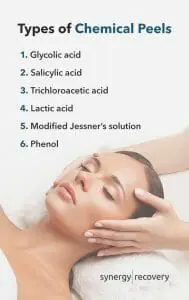
A chemical peel, unsurprisingly, involves chemicals, but professionals may choose various options. The type of peel you receive will vary with where you go for treatment, your skin type and tone and the results you desire. Some common types of chemical peels include the following.
- Glycolic acid can be helpful in acne treatments and at addressing different concerns.
- Salicylic acid has antimicrobial, anti-inflammatory and skin lightening properties.
- Trichloroacetic acid is often the main ingredient in medium-depth peels. It’s usually for smaller, focal areas, like blemishes or uneven skin tone.
- Lactic acid is common in superficial peels. It can treat fine wrinkles or dryness.
- Modified Jessner’s solution contains resorcinol, salicylic and lactic acids. It can address pigmentation in darker skin tones.
- Phenol is a chemical for deep treatments. It can address wrinkles, sun-damaged skin, uneven texture and other issues.
Best Chemical Peel for You
Customization is essential for any skin care treatment. Your skin is unique, and that’s why at Synergy Wellness, we work to personalize skin peel treatments to the individual. We’ll ensure you get the very best benefits from your peel. When you visit a skin care professional for a skin peel, they should address qualities and needs, including the following.
- Your skin tone: Chemical peels are typically best for people with lighter complexions. But there are safe chemical peel options for dark skin. From there, a professional can recommend a chemical peel for you based on your complexion and whether you have an uneven skin tone you’d like to address.
- Your skin sensitivity: Those with extremely sensitive skin will need to discuss treatment options with an aesthetician. There are chemical peels for sensitive skin, but a professional will need to evaluate your sensitivity.
- Your skin concerns: During a consultation, come prepared to discuss what you want to improve about your skin. Do you have acne or acne scars? Are there signs of aging you’d like to address? You may even have a combination of damaged skin concerns you want to remedy.
Who Performs Your Chemical Peels?
You should seek a skilled professional to provide chemical peel treatments because it can be a risky process in untrained hands. What type of professional you should see will depend on the type of peel you want. Licensed physicians, like dermatologists, can provide deeper treatments. An aesthetician can do moderate or light peels. You’ll want to see a trusted professional who has completed extensive training to give you the best experience and results. At Synergy Wellness, we’ve assembled a team of professionals ready to help you regain your happiness and healthy glow.
Dr. Jan Trobisch performs most of the cosmetic procedures at Synergy Wellness. He completed his medical education at Germany’s Freie Universität Berlin before coming to the United States. Trobisch then completed residency training in Harrisburg, Penn., and in Bakersfield, Calif. He specializes in treating substance use disorders, but has expanded his skills over the years to include medical aesthetics. Specialized cosmetic training in both Germany and West Hollywood gave him the skills and experience to provide his clients with the only “European touch” in Bakersfield.
Chemical Peel Process
Before you and an aesthetician or dermatologist decide if a chemical peel is right for you, learn a bit about the process. A skin peel involves steps you should take before and after treatment. There’s also the process of a chemical peel to consider.
What to Do Before a Chemical Peel
As you schedule your appointment for a treatment or consultation, your aesthetician or dermatologist will let you know what to do before the procedure. Leading up to your skin peel and consultation, you should take these steps to prepare.
- Know your medical history: In a consultation before your treatment, the aesthetician will likely ask about your medical history. Come prepared with the names of any medications you take or any cosmetic procedures you’ve had in the past.
- Follow any pre-treatment regimens: Your aesthetician may recommend products like hydroquinone or topical tretinoin leading up to your treatment. These will vary based on your skin type and the treatment you’re getting, so follow your specific instructions.
- Avoid sun exposure: In the days ahead of your chemical peel treatment, stay out of the sun. If you do need to be outside, wear protective clothing and a broad-spectrum, high-SPF sunscreen.
- Avoid specific cosmetic and hair products or treatments: Your aesthetician will tell you what not to do in the week leading up to your chemical peel appointment. In general, you should avoid face masks or scrubs and hair dyeing, straightening or perming treatments.
Chemical Peel Process
The chemical peel process will vary slightly based on who does the treatment and what treatment you have done. In general, the process involves these steps, where the doctor or aesthetician will:
- Protect your hair and eyes, depending on where you’re getting the treatment done.
- Provide sedatives or use numbing agents, usually based on the depth of your treatment.
- Apply the chemical solution with something such as a brush, gauze, sponge or cotton ball.
- Apply a neutralizing solution, if necessary, or wash the chemical solution away.
- Do the procedure in short intervals for a deep skin peel.
The length of your chemical peel process will depend on a few factors. The depth of the treatment and the area of skin the aesthetician or dermatologist will treat affect procedure time. Your procedure can take anywhere from 30 to 90 minutes.
On the day of your procedure, you may need to arrange for a ride home. Some chemical peels involve sedation, which will leave you groggy once the treatment is over. If you’re getting a skin peel around your eyes, you may experience swelling that would make it difficult to see.
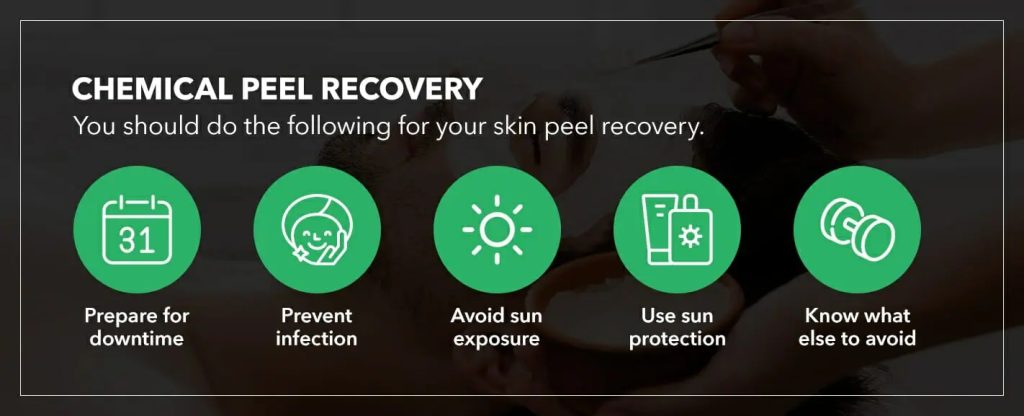
Chemical Peel Recovery
After a skin peel, you need to give your skin time to recover and heal. So how long does it take to recover from a chemical peel? Chemical peel recovery is different for everyone. It changes with the treatment you want and your skin type, but it could take a few days to a few weeks. In general, you should do the following for your skin peel recovery.
- Prepare for downtime: You may experience a slightly swollen or red skin reaction after your chemical peel. You could also see peeling or feel a tightness or itching. Those are common after a skin peel and come with the healing process. If possible, plan for one to two weeks of downtime, based on your treatment and doctor recommendations.
- Prevent infection: Promote the healing process by keeping your skin clean to prevent infection. Gently soak and cleanse the skin as the aesthetician recommends, applying suggested products to protect the healing skin.
- Avoid sun exposure: After a chemical peel, your skin is more susceptible to sun damage. Try to schedule your treatment for times of the year with less sun exposure or stay indoors as often as you can.
- Use sun protection: If you must go outside, you may need to cover up or wear sunscreen. Your aesthetician can recommend the best sun protection based on your treatment.
- Know what else to avoid: Skip activities like exercising or sauna visits, which increase blood circulation and sweating. Those and other activities could have uncomfortable side effects as your skin heals.
Chemical Peel Cost
According to the American Society of Plastic Surgeons, the average chemical peel cost $644 in 2019. What you pay will depend on where you go and what treatment or treatments you get. So, you could end up paying more or less than that average. A superficial or light chemical peel, for instance, could cost around $150. A deep chemical peel, on the other hand, could have a price in the thousands.
Speak with an aesthetician for potential pricing. They may be able to give you an estimate based on your desired treatment and the area of skin you’re getting treatment for. Factor in the cost of any products you need to use before and after your treatment, as well.
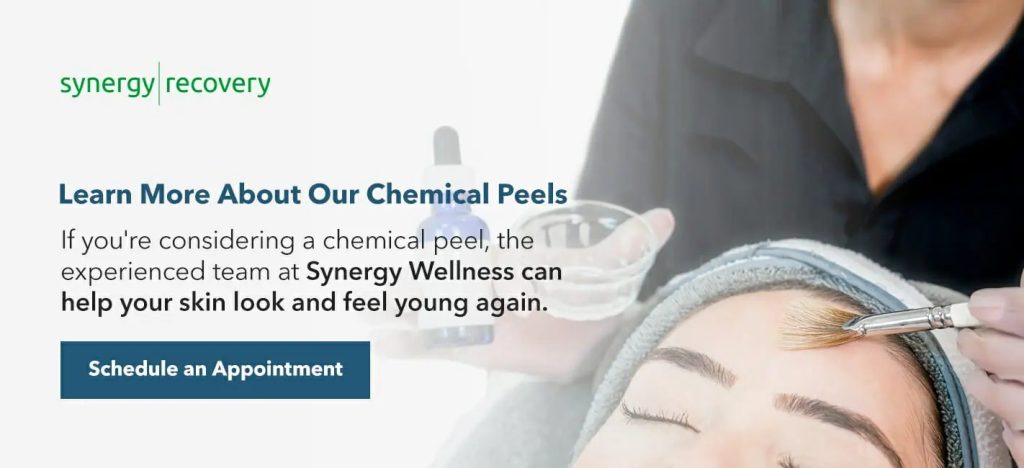
Contact Us to Learn More About Our Chemical Peels or Book an Appointment Today
If you’re considering a chemical peel, the experienced team at Synergy Wellness can help your skin look and feel young again. We’re highly trained and motivated professionals who are ready to help you achieve the complexion you’ve always dreamed of. Feel transformed with an even complexion, reverse years of sun damage or fight signs of aging. Synergy Wellness will help you reveal your skin’s natural beauty.
Contact Synergy Wellness at 661-878-9100 to learn more about chemical peels or book your appointment in Bakersfield. Let us refresh your skin and restore your happiness and confidence with a youthful glow.
cript type=”application/ld+json”>
{
“@context”: “https://schema.org”,
“@type”: “BlogPosting”,
“mainEntityOfPage”: {
“@type”: “WebPage”,
“@id”: “https://synergywellnesscenter.com/blog/learn-about-chemical-peels/”
},
“headline”: “Chemical Peel Cost: Learn About What You Are Paying For”,
“description”: “There’s no reason you can’t be happy with your skin and have a healthy glow, especially with chemical peel treatments available. If you’re considering this skin treatment, you probably have a few questions. In the guide below, you’ll learn about the chemical peel cost and what treatment entails. Decide if a skin peel is right for you to regain your healthy, happy skin.”,
“image”: [
“https://synergywellnesscenter.com/wp-content/uploads/2021/10/01-Chemical-peel-cost-learn-about-what-you-are-paying-for.jpg”,
“https://synergywellnesscenter.com/wp-content/uploads/2021/10/02-What-are-the-benefits-of-a-chemical-peel.jpg”,
“https://synergywellnesscenter.com/wp-content/uploads/2021/10/03-Types-of-chemical-peels-pinterest-189×300-1.jpg”,
“https://synergywellnesscenter.com/wp-content/uploads/2021/10/04-Chemical-peel-recovery.jpg”,
“https://synergywellnesscenter.com/wp-content/uploads/2021/10/05-Contact-us-to-learn-more-about-our-chemical-peels.jpg”
],
“author”: {
“@type”: “Person”,
“name”: “Jan Trobisch, MD”,
“url”: “https://synergywellnesscenter.com/blog/author/nicknamejan/”
},
“publisher”: {
“@type”: “Organization”,
“name”: “Synergy Wellness Center”,
“logo”: {
“@type”: “ImageObject”,
“url”: “https://synergywellnesscenter.com/”
}
},
“datePublished”: “2020-10-17”,
“dateModified”: “2023-09-22”
}

